What Salt Need To Put In To Saltwater Fish Tank
For beginner aquarists to saltwater one of the most daunting tasks is correctly making the saltwater itself. The thought of getting it wrong and everything dying fills many beginners with dread, but it is actually a very straightforward process.
For a home saltwater aquarium, the common salt content in the h2o needs to remain consequent at around 1.025 S.G. or 35ppt. Purposely engineered aquarium salt granules mix at a ratio of 1/2 loving cup or 135g for every gallon of freshwater. The apply of a hydrometer or refractometer volition be needed to test the ratio.
Once you have read this article you volition have no fears almost what you need and how to mix the salt and h2o to give you the perfect mix prepare for addition to your new shiny aquarium. It is very directly forward and yous will go a water change chief in no time!
Before you begin mixing, you demand to ensure yous have the right kind of common salt for the aquarium. Regular table salt will not do!
What Kind of Salt Mix Should You lot Employ in an Aquarium?
Common salt mixes for home aquariums are highly engineered to provide optimal water conditions for fish, coral, and invertebrates. It is not only the salinity that they provide only dozens of trace elements similar Calcium, Magnesium, Carbonate, Strontium that the invertebrates employ as building blocks for their skeletons.
In that location are many great brands that accept decades of full-blooded behind them so picking a salt is easy. The salt that I have personally been using for over a decade is Reef Crystals from Instant Ocean.(Amazon Link)
Each brand of common salt can mix may exist mixed to slightly unlike quantities so exist certain to always read the manufacturer's information when starting a new make of table salt. Some mixes are peculiarly made for fish-only aquariums, whereas Reef Crystals is aimed at aquariums with large coral populations. No affair which common salt mix you option, they will all work, the ones with more trace elements for corals are just a little more expensive!
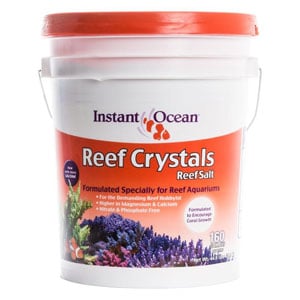
When selecting a table salt mix stay abroad from freshwater aquarium salt which is used by freshwater aquarists to recreate brackish water conditions. Although these salt mixes will work to create the correct salinity they do not comprise the trace elements like sodium, chloride, sulfate, and magnesium necessary for marine organisms to thrive.
TBR Recommends
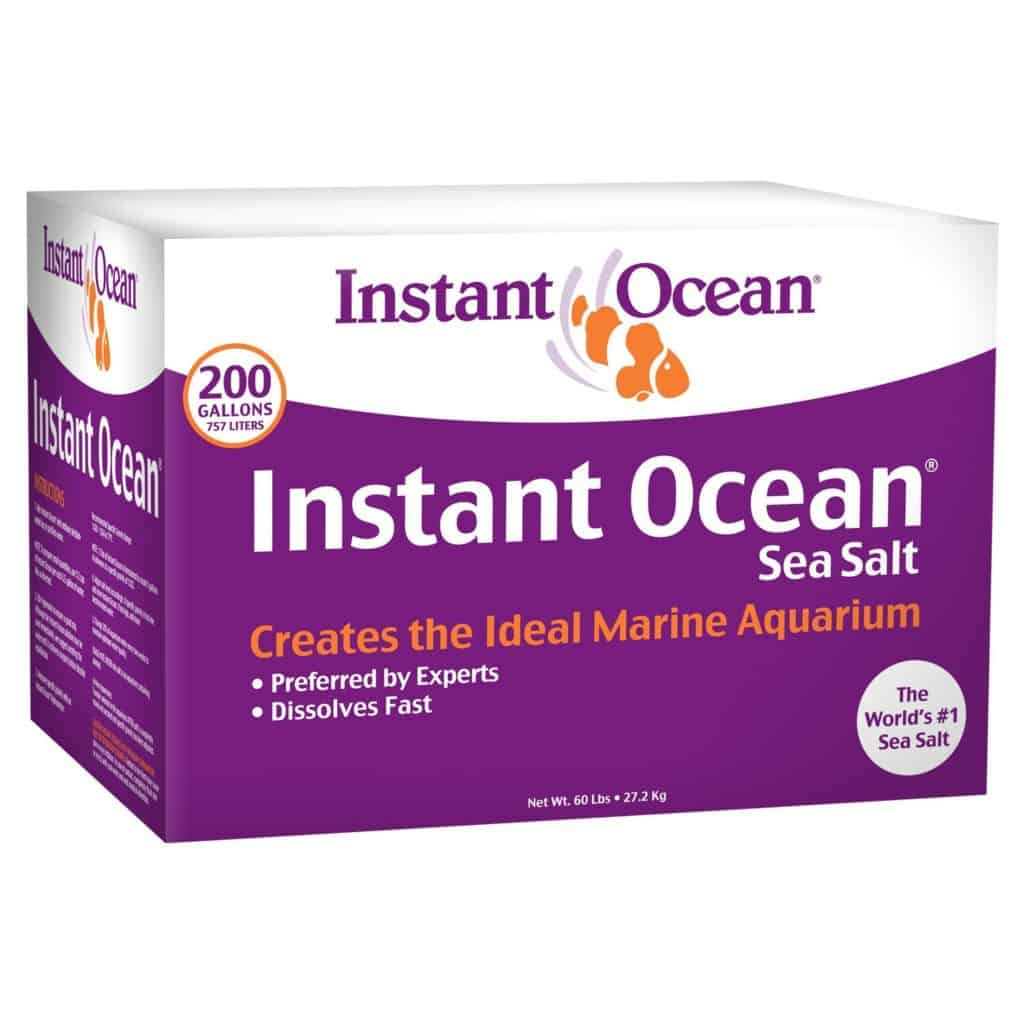
Detect a Slap-up Selection of Aquarium Table salt Mixes at Amazon.com
How Much Salt Mix Should You Use in an Aquarium?
Each manufacturer is slightly different for what is recommended to achieve a salinity or specific gravity of effectually the recommended 1.025sg or 35ppt (Parts Per Thousand). This figure is also based on the water temperature being at 25°C/77°F.
Most saltwater aquariums run at a temperature of around 78°F (25.v°C) to fourscore°F (26.half dozen°C) and so the salt mixes will have to be measure and tweaked to ensure 1.025sg at your selected temperature – I run my aquarium at 78°F
Some brands will give you a volume to mensurate, whereas other brands volition requite you a weight to measure out. Whichever brand yous option, just follow the instructions printed on the side of the packaging. Just measure the recommended amount of table salt granules and add it to the mixing container with freshwater. A pump is and then used to mix information technology and a heater to warm it.
This then turns your bucket of water into saltwater!
Hither are some of the all-time table salt mixes for beginners and how each manufacturer recommends they are measured to accomplish a salinity of 1.025 at 25°C/77°F:
| Common salt Make | Mixing Recommendation |
|---|---|
| Instant Body of water | 1/two Cup per 1 U.S. Gallon |
| Red Ocean Common salt | 136g per 1 U.South. Gallon |
| Tropic Marin Archetype Salt | 1/2 Cup per 1 U.S. Gallon |
| Neomarine Salt Mix | 134g per 1 U.S. Gallon |
How To Correctly Mix Aquarium Salt
If this is going to be the start fourth dimension y'all have mixed saltwater for your new aquarium there is a fairly simple procedure that you tin use, but you will need to get together the following items before you lot start:
(All Links to Amazon.com for Reference)
- Make clean/Unused Saucepan for small-scale aquarium. Beast Trashcan for Large Aquariums
- Heater
- Thermometer – I like the digital ones for piece of cake reading
- Small Powerhead pump for mixing
- Measuring Cups or Baking Scales
- Refractometer
- Quondam Towels
- RO/DI Water Filter or Decholrinating Solution for Tap Water
Before you brainstorm exist sure to place downwardly towels, salt granules or saltwater can stain carpets and flooring!
Pace 1
If you lot accept a brand new tank you tin can practise your mixing in the tank but do not add the live sand or live rock at this bespeak. The freshwater volition kill all living organisms and beneficial bacteria on them.
Do not utilise any detergent when rinsing your new bucket/trashcan, but warm h2o and a fabric to wipe away manufacturing oils.
Nutrient grade containers are recommended because depression-grade plastic can leach phosphate into the water over fourth dimension.
If you wish to do your aquascape and insert the sand first, then mix your water in the trashcan/bucket.
Step 2
Fill the tank or container with water. If you can, get yourself an RO/DI water filter (See Further Reading department at the end) to help prevent water quality issues for the life of your aquarium! If non, utilise the Prime Decholrintor solution to treat the tap water as per its dosage instructions.
If y'all are mixing in the aquarium, exist sure to but fill to around seventy% of the volume of the aquarium to leave room for stone and sand displacement when you lot add them later.
Stride three
Plow on the heater and pump to circulate and bring the water up to 78°F.
Footstep 4
Once upward to temperature, brainstorm to add the table salt following the manufacturer's recommended dosage of around 1/ii cup or 135g per U.s. gallon.
Step 5
Allow the water pump to mix the water and salt solution. Don't worry if y'all see any sand-similar residue or cloudy water, that is normal. Ensure all salt granules get dissolved.
Stride six
After effectually 30 minutes take a salinity reading. Add together water if the salinity is too loftier, add more salt if the salinity is too low.
Step 7
Allow mixing for several hours to several days to get the salinity content expressionless on. Repeat Step vi as needed.
Step viii
If you decided to add your stone and sand after, now is the time to practice it. Slowly add your rock to create your aquascape, and so add the sand! Adding rocks on top of sand tin can crusade them to topple when burrowing critters get added to your tank. Rock on glass is fine, just be slow!
Stride ix
Mix some more saltwater in your bucket/trashcan and add information technology to the aquarium to bring up the water level to the correct operating height once all the rock and sand is in. Be sure to fill plenty for the sump/filters.
Step 10
Your tank volition go cloudy for several days, allow the filters to run and pull out the suspended debris.
Your aquarium is now full and you tin can brainstorm the fun of cycling the tank ready for it to go a full saltwater reef tank!
For lots more detailed manufactures on water changes and cycling your tank be certain to cheque out the Farther Reading department at the terminate of this commodity.
How Exercise You lot Measure the Salinity of a Saltwater Mix?
The unit of measure for salinity is known as specific gravity or sg. The platonic salinity for a home aquarium is i.025sg but the tolerable range is 1.021sg to 1.026sg depending on what livestock you have. Pure water has a specific gravity of 1sg. If your saltwater mix measures 1.025sg, information technology ways that it is 1.025x denser than pure water.
Fish merely aquariums can be at the lower cease of the scale of around 1.021sg, whereas SPS corals adopt to exist up at around i.025sg. The lower the salinity, the less common salt mix you lot use so information technology becomes cheaper when doing h2o changes.
My recommendation is that if you wish to merely go along fish, then mix your h2o to 1.021sg, if you plan on keeping invertebrates and corals so begin your aquarium at 1.025sg.
To be able to measure the amount of salt content in your h2o there are 3 options bachelor to the aquarist:
- A Hydrometer – Cheap, but difficult to read
- A Refractometer – ost Used Option
- An Electronic Salinity Meter – Highly accurate merely xxpensive
Permit's go into a brief introduction of each of these measuring instruments:
Hydrometers
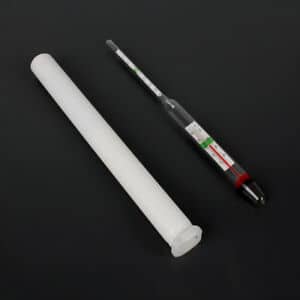
Hydrometers measure out specific gravity by using the concept of buoyancy. You float the hydrometer on the surface of the water and it will give yous the sg reading based on where the h2o level touches its measuring stem. Reading the stem tin can exist quite difficult.
Refractometers
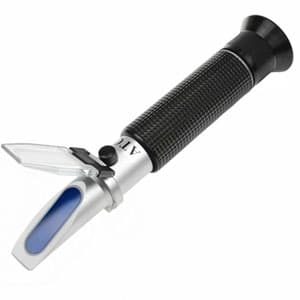
Refractometers make up one's mind salinity past measuring the light refraction acquired by the salt in the water and self-correct for temperature. You place a drib of water on the prism and view the result through the eyepiece. They are fast to employ and tin can be hands calibrated with a simple solution.
A Refractometer is what I recommend y'all use. For effectually $35 it volition last you forever (mine is 15 years sometime and withal works perfectly!) and give you lot highly accurate results within 30 seconds of taking it out of the box!
You can find one Hither at Amazon.com
Electronic Salinity Meters
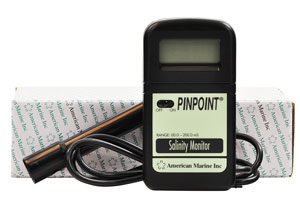
Salinity meters use a sensor to measure the common salt content in the water. They are very unproblematic to use and give an like shooting fish in a barrel-to-read numerical value. They are easily calibrated using a test solution.
For lots more detailed information almost measuring salinity please encounter our article in the further reading section below.
To Finish
In order to create artificial saltwater, use every bit pure a water source equally you can and a recognized aquarium table salt mix.
Use the recommended dosage of around i/2 cup or 135g per gallon, but be sure to follow the specific instructions provided by the table salt manufacturer to attain a salinity reading of around 1.025sg at 78°F for your new aquarium. For partial water changes, salinity and temperature levels must match that of the existing tank water.
Farther Reading
Before y'all get too far unto your aquarium journeying I recommend the following manufactures to help you progress seamlessly:
- How To Select An RO/DI Arrangement For Your Aquarium
- How To Measure Salinity In An Aquarium
- Fish Tank Nitrogen Cycle – Step-Past-Step Explanation
- How Frequently Should Y'all Change H2o In Saltwater Aquariums?
- Saltwater Aquarium H2o Modify – Your First Time
- What Needs To Be Tested In A Saltwater Aquarium?


What Salt Need To Put In To Saltwater Fish Tank,
Source: https://www.thebeginnersreef.com/how-much-aquarium-salt-per-gallon-its-really-simple-to-do/
Posted by: norwoodthisper.blogspot.com


0 Response to "What Salt Need To Put In To Saltwater Fish Tank"
Post a Comment